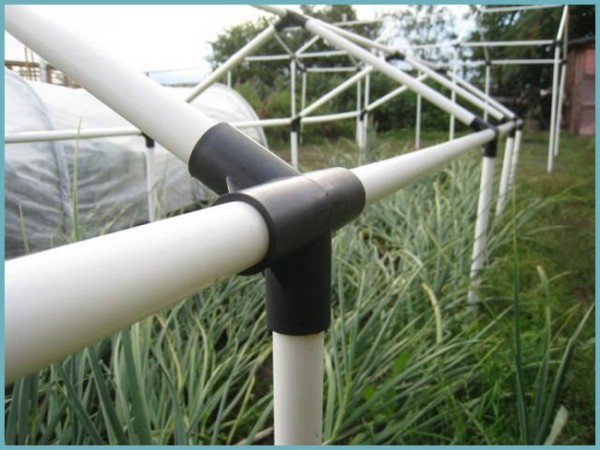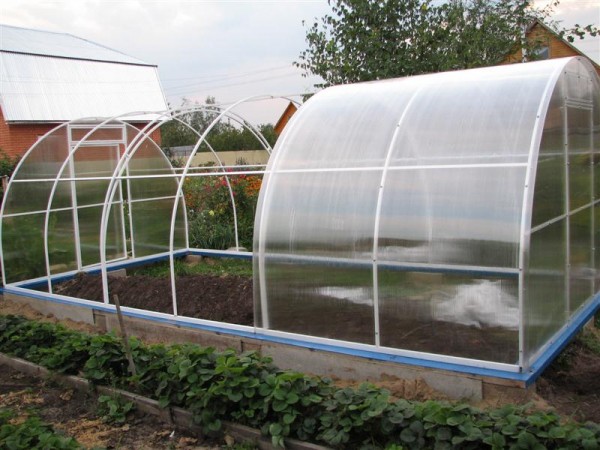DIY PVC pipe greenhouse: drawings and assembly features
Content
Preparing drawings
Any construction, even the smallest and insignificant, should begin with drawing up an action plan and drawing. To do this, first of all, you should figure out what types of greenhouses exist. Consider the most common: arched, single-slope, gable.
An arched greenhouse is a structure with an arched roof. This shape of the upper part of the structure allows the plants to receive more light, as the rays of the sun are scattered over the curved surface. Arched greenhouses are better preserved in winter, since snow does not accumulate on the roof, under the weight of which the entire frame of the greenhouse can deform. The lean-to greenhouse joins one side to the other building. This option is quite budgetary and at the same time significantly saves space on the site. The disadvantage of a lean-to greenhouse is that in winter it is necessary to regularly clean off snow from it, since the roof structure does not allow it to roll off spontaneously.
The most popular type of greenhouse among domestic gardeners and gardeners is a gable. In this design, the roof is in the shape of a triangle. The undoubted advantage of such a structure is the presence of a large space for plant growth. Having decided on the type, it is necessary to draw up a construction plan and calculate the amount of materials required.
For a greenhouse you will need:
- boards that need to be impregnated with an antiseptic before starting construction;
- PVC pipes for the frame;
- plastic film or polycarbonate;
- rods (50–6о cm high);
- nails, screws, screws, hinges, handles;
- loops for fastening PVC pipes.
Site preparation
Choosing the right place for installing a greenhouse, be it a seasonal or permanent building, is the key to the success of the entire event. It is best to find a sunny and draft-free place. Other country buildings or a solid capital fence can act as protective elements here, it is clear that there will be no sense from the picket fence.
Basic rules to help you choose the best option for placing a site under a greenhouse:
- the distance to the nearest one-story buildings must be at least 3 m, otherwise the shadow from adjacent structures will obscure the greenhouse;
- you should also place the greenhouse at some distance from bushes and trees, since they will not only make shade, but also their roots will take away moisture from the greenhouse inhabitants and destroy the foundation of the entire building;
- the ends of the greenhouse should be placed so that they face north and south, and the long walls of the structure should be parallel to the east-west line. This placement will maximize the provision of plants with warmth and light throughout the day.
After deciding on a place, it is necessary to prepare a site for construction.First of all, you need to mark the desired area with pegs, and then thoroughly clean and level this area well. Visually, the site should be without slopes and holes. Otherwise, the entire structure will be skewed, and this will cause an uneven distribution of the load on the greenhouse surface (strongly affects the strength during winds and snowfalls).
Installing the frame
First of all, a wooden frame (pre-treated with an antiseptic) is installed on the ground, which will fix the PVC pipes. Its dimensions correspond to those of the greenhouse. Then a peg or reinforcement (length 50-60 cm) is mounted, on which the frame of the greenhouse will be installed. After fixing the pins, prepared PVC pipes are put on them. Keep in mind that it is extremely difficult to bend the pipe on your own, so involve volunteer assistants from among relatives, friends or neighbors to the work.
Having put the pipes on the pins, they need to be fixed by attaching them to the wooden frame with the help of special holder loops and self-tapping screws.After completing the assembly of the main frame of the greenhouse, the entire structure should be strengthened by securing additional PVC pipes from above and from the sides. They should be centered on the roof and side walls. It is better to use plastic ties for attaching additional pipes. At the final stage of construction, a self-made PVC greenhouse is covered with foil or polycarbonate.
Video "Algorithm for creating a greenhouse"
In this video, you can see the algorithm for creating a greenhouse from plastic pipes.
Film or polycarbonate
When choosing a cover for a greenhouse constructed from PVC pipes with your own hands, it is worth considering that it must be light, otherwise the frame will not withstand the load and collapse. Therefore, you should immediately exclude the option with glazing, and dwell on the following types of coatings for greenhouses:
- Film greenhouse. Plastic film, as a cover for a greenhouse with your own hands, has a number of advantages and disadvantages. This material is quite budgetary, as well as simple and easy to use. To cover the mounted greenhouse with foil, you do not need to make any special efforts. This material is very light, so it can be easily removed to ventilate the greenhouse. For the winter period, the plastic wrap must be dismantled and stored in a warm place. On the one hand, this is unnecessary trouble at the end of the season and at the beginning, when the greenhouse needs to be covered again, and on the other hand, there is no need to worry that during snowfalls the structure will not withstand the pressure and collapse.
- Polycarbonate greenhouse. Polycarbonate is a plastic that is as close to glass in transparency as possible, but much stronger and lighter. This material has excellent heat retention, making it the best material for year-round greenhouses.
Also, the indisputable advantage of polycarbonate for covering do-it-yourself greenhouses is its durability and strength. Having well mounted the structure, for many years you can forget about the hassle of arranging a greenhouse on your site. When choosing polycarbonate, pay special attention to its density - less dense sheets bend more under the weight of snow, therefore, they will require more maintenance. Greenhouses made of PVC profiles are the best option for placement in small summer cottages and adjoining territories. Their construction takes little time, requires insignificant physical and financial costs. This type of greenhouse is characterized by low weight, high reliability and durability.
Video "Features of building a polycarbonate greenhouse"
The author of this video shares his experience in buying and building a polycarbonate greenhouse.





